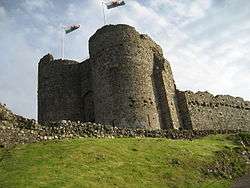Criccieth Castle
| Criccieth Castle | |
|---|---|
| Part of Gwynedd | |
| Criccieth, North Wales | |
|
The remains of the great gatehouse at Criccieth Castle. | |
 Criccieth Castle | |
| Coordinates | 52°54′58″N 4°13′57″W / 52.916°N 4.2325°W |
| Type | Enclosure Castle |
| Site information | |
| Controlled by | Cadw |
| Condition | Ruinous |
| Site history | |
| Built | c.1230-1280s |
| Built by |
Llywelyn the Great Llywelyn ap Gruffudd James of St George |
| In use | Open to public |
| Materials | Siltstone |
| Events |
Welsh Wars Prince Madoc's Rebellion Owain Glyndŵr rebellion |
Listed Building – Grade I | |
Criccieth Castle (Welsh: Castell Cricieth) is a native Welsh castle situated on the headland between two beaches in Criccieth, Gwynedd, in North Wales, on a rocky peninsula overlooking Tremadog Bay. It was built by Llywelyn the Great of the kingdom of Gwynedd but it was heavily modified following its capture by English forces of Edward I in the late 13th century.
Construction
Although the stone castle was begun in the 1230s, there were three main building phases plus several periods of remodelling. The earliest part of the masonry castle is the inner ward which was started by Llywelyn the Great. Unlike most other Welsh native strongholds, the inner ward at Criccieth was protected by a gatehouse with twin D-shaped towers that was protected by a gate and portcullis, with murder holes in the passage, and outward facing arrowslits in each tower. This design might have been copied from English designs on the Marches at Beeston Castle, Cheshire or Montgomery Castle, Shropshire. The two towers of the gatehouse provided accommodation and their height was later increased in the Edwardian period. The castle's well was also in the gatehouse passage which was supplied by a spring fed cistern.
In the 1260s or 1270s, an outer ward was added during the second building phase under Llywelyn ap Gruffudd. A new gateway was added in the outer curtain with a large two-storey rectangular tower. The castle, although not a proper concentric design, now had two circuits of circular defences.
Criccieth was taken by English forces in 1283. Under James of Saint George, another two storey rectangular tower connected to the rest of the castle by a curtain wall, the "Engine Tower" (now in ruins) might have been the foundation for a siege engine. The gatehouse had another storey added and several Welsh mural towers were strengthened. An outer barbican was added to the outer curtain wall.
Under Welsh stewardship, the principal residence was in the SW tower but when the castle was taken over by the English, accommodation was situated in the towers of the D-shaped gatehouse. Timber buildings, which included a great hall, were erected within the inner ward.
History
A Motte and bailey stood at a different site in Criccieth before the masonry castle was built. In 1283 the castle was captured by English under the command of Edward I. It was then remodelled by James of St George.
In 1294, Madoc ap Llywelyn, a distant relation of Llywelyn ap Gruffudd, began an uprising against English rule that spread quickly through Wales. Several English-held towns were razed and Criccieth (along with Harlech Castle and Aberystwyth Castle) were besieged that winter. Its residents survived until spring when the castle was resupplied.
In the 14th century the castle had a notable Welsh constable called Hywel ap Gruffydd, known as Howell the Axe, who fought for Edward III at the Battle of Poitiers in 1356.
The castle was used as a prison until 1404 when Welsh forces captured the castle during the rebellion of Owain Glyndŵr. The Welsh then tore down its walls and set the castle alight. Some stonework still show the scorch marks.
Criccieth was also one of several locations Romantic artist Joseph Mallord William Turner used for his famous series of paintings depicting shipwrecked mariners.
Present day
The castle is maintained by Cadw. It includes exhibits and information on Welsh castles as well as the Anglo-Norman writer Gerald of Wales.
Constable
The constable of the castle was ex officio also the Mayor of Criccieth.
List of Constables
Source The Castle Community: The Personnel of English and Welsh Castles, 1272-1422
- 1284: William de Leybourne
- ?–1309: William le Butiller
- 1309–1316: William Trumwyn
- 1316–?: John de Welles
- 1317–1321: Oillard de Welles
- 1321–?: John de Swennerton
- 1322–1326: Thomas Jay
- 1326–1327: William de Shaldeford
- 1327: Richard de Munemuth
- 1330–?: Richard de Holland
- 1333: Richard de Allespath
- 1333–death: Richard de Holland (restored)
- ?–1338: Robert de Hambury
- 1338–1343: John le Strange of Muddle
- c.1347–c.1359: William de St Omer
- 1359–?1381: Hywel ap Gryffydd (Hywel y Fwyall- Howell the Axe) (died 1381) [1]
- 1381–1391: Thomas Beushef
- 1391–?: William Frodesham
- 1396–1398: William Hugon
- ? –1398: John Gamull
- 1398–?: William Hugon and John Gamull
See also
References
External links
| Wikimedia Commons has media related to Criccieth Castle. |


